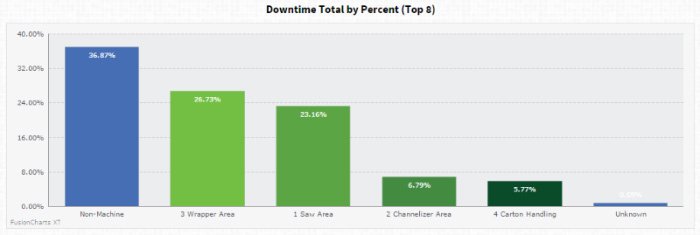Obviously, it goes without saying that any instance of unplanned downtime costs your organization money. To remain as profitable as possible in an industry like pharmaceuticals, you obviously need to take whatever meaningful steps you can to consistently improve both the capabilities and the productivity of your production line.
But at the same time, downtime is so much more than just an “inconvenience.” According to one recent study, the costs associated with unplanned instances of downtime can eat up between one and three percent of your revenue…and potentially as much as 30 to 40% of your profits, too. Not only that, but the same source indicated that when you’re talking about large capital equipment, you could be losing between one and three percent of the value of those assets per year.
Of course, that’s not all. There are a number of other costs of downtime in this industry in particular that you need to be aware of moving forward.
Downtime in the Pharmaceutical Industry: Breaking Things Down
By far, the biggest cost of unplanned downtime in the pharmaceutical industry comes by way of the potentially irreparable damage you’re doing to your reputation.
Unlike other industries, instances of downtime aren’t just delaying a product getting into the hands of the people who need it. They’re directly responsible to delaying often critical patient care. The longer this goes on, the more damage is done – and at a certain point, there really is no coming back from that in terms of the public eye.
Equally complicating things is the cost of not being HIPAA complaint – something that also contributes to reputational damage, but that can easily add to enormous financial costs as well. Any organizations working in the healthcare space have to comply with certain business continuity standards – there really is no getting around this. The financial penalties and fines associated with not being compliant aren’t just significant… they can potentially be devastating.
Finally, you arrive at what may be the biggest cost of them all: the cost to patient safety and care across the board. If people are out there depending on the products that you’re making, they need those items as quickly as humanly possible. Every instance of unplanned downtime means that medications that people need to maintain a certain quality of life may not be given on time. Truth be told, they may not be given at all.
Crucial patient care may be delayed due to the ripple effect that your unplanned downtime events are causing. Workflows will need to be adjusted, which only opens the door for more mistakes further down the supply chain.
All of these things add up… which is why downtime tracking software is and will always be one of the best ways to protect not only everything you’ve already worked so hard to build, but the customers you’ve ultimately dedicated yourself to serving.
Downtime tracking solutions like Thrive do more than just tell you when downtime is taking place. They also help illustrate why these problems are occurring, all so that you can take actionable steps to prevent them from happening again in the future.
Not only will you be able to use downtime tracking to see what is working, but more importantly you’ll also be able to see what isn’t – all so that you can double down on the former and get rid of the latter at your earliest opportunity.
In an industry like pharmaceuticals, the stakes couldn’t be higher – which is why downtime is something both you and your customers cannot afford to deal with. Luckily, downtime tracking tools exist to help mitigate risk from these types of instances as much as possible.

